Ventilation in the bathroom is not only desirable, but also a necessary condition for a comfortable stay. It ensures dryness, prevents the growth of foci of mold, eliminates unpleasant odors when it comes to a combined bathroom.
Indoor ventilation shafts do not always cope with metabolic processes, so air circulation is hampered. Forced exhaust can be organized by installing a fan in the room.
It is often practiced to connect the hood in the bathroom to a light switch - this way you can combine the use of lighting and a fan. Consider the best schemes suitable for self-installation, and dwell in more detail on the process of selecting and installing electrical equipment.
The content of the article:
-
Connection diagrams of the hood to the switch
- Option # 1 - through a one-button switch
- Option # 2 - via a two-button switch
- Option # 3 - installing an additional switch
-
General installation instructions
- Stage 1 - execution of "rough" work
- Stage 2 - preparation of tools and materials
- Stage 3 - completing the connection process
- What do experienced electricians advise not to do?
- Conclusions and useful video on the topic
Connection diagrams of the hood to the switch
After the purchase exhaust fan in the bathroom the question arises about its installation and connection to the home power grid. So, there are many ways to turn on the fan, but two schemes are recognized as expedient: connecting the exhaust fan through a one-button switch and pairing it with a two-button device. Each of the schemes can be performed in two versions, which depend on the type of the hood - with or without a timer.
As an alternative method, we present an autonomous adjustment carried out using a separate switch. It is used less often, since a 2-key controller is much more convenient to use than two 1-keys, and installation is easier and faster.
Option # 1 - through a one-button switch
First, let's talk about how you can connect the hood in the bathroom at the same time as the switch. We offer two simple solutions suitable for a forced ventilation in the bathroom - both in a separate and in a combined bathroom.
In the first case, we will use an ordinary fan built into the wall opening of the ventilation shaft, in the second - a more advanced model with a timer.
We connect the fan and light to the general switch
The advantage of this method is in saving space, simpler and faster installation and the same simple use. Before entering the bathroom, one switch is installed, to which the wires from the lamps and the fan are connected. When you press the key, all devices are turned on at the same time, and they are turned off, respectively, also at the same time.

Wiring diagram for the exhaust hood and lamps to a one-button switch. The ground loop from the light bulb is connected to the ground bus. Instead of one lighting fixture, you can use several
If required, a step-down transformer and a power supply are additionally connected to the luminaires. Protective grounding is necessary if the luminaire housings are made of metal or have metal elements - this is especially important in a humid environment.
The disadvantage of the circuit is obvious - the fan will rotate only when the lights are on. If the airing needs to be extended, the lighting will have to be left on, and this is an extra cost for paying for electricity.
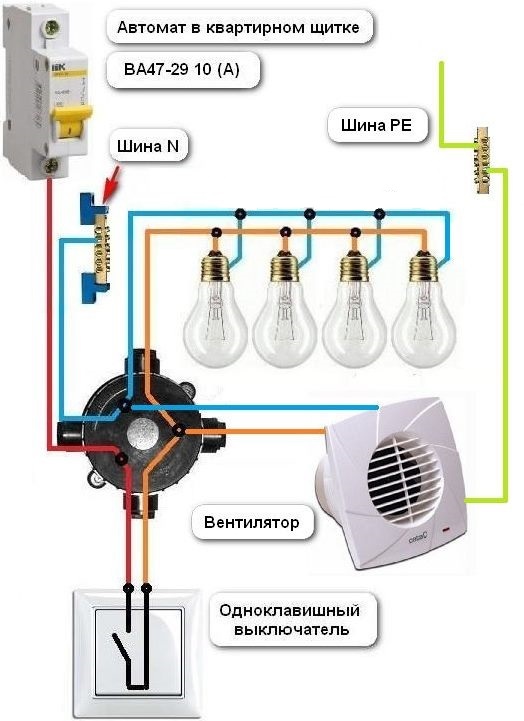
Schematic for a bathroom lighting system with several lamps. The lighting circuit N in the junction box forks: one wire goes to the N bus, the second to the fan
But for some, this method will be the most convenient. For example, for summer residents who live in the house only in the warm season and rarely visit the bathroom. If the family is large, the humidity level in the bathroom is always high, so it is better to use a two-button switch.
The fan with a timer and the light are connected to the switch
The difference between this option is that we are not using a simple model, but with a timer that regulates the on / off time of the hood. For more information on the types of fans, see this article.
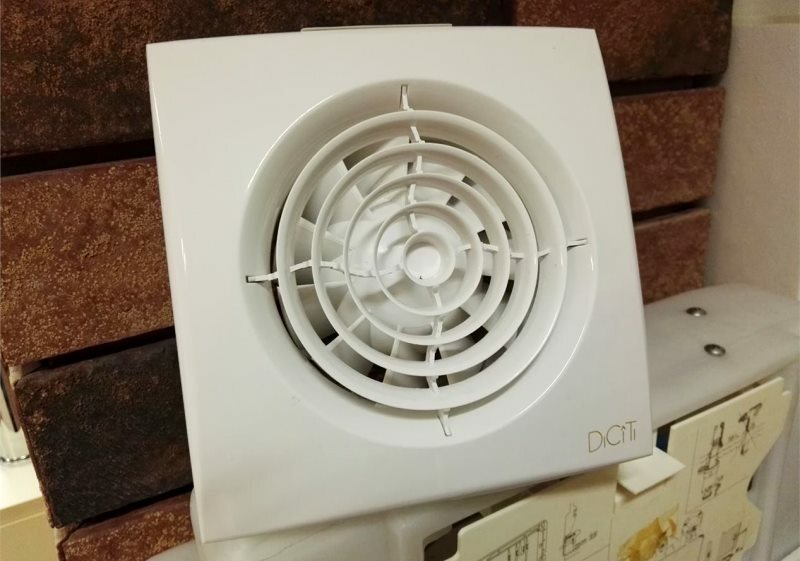
If you do not want to overpay and buy a device with many useless functions, we recommend a simple model with an electronic timer. Design - classic, noise level - low
The advantage of this solution is that you do not have to leave the lights on in order to properly ventilate the room. When the button is pressed, both the lighting and the fan are activated, but when pressed again, only the lamps are turned off.
The fan will run for as long as you program it, and then it will turn off automatically.
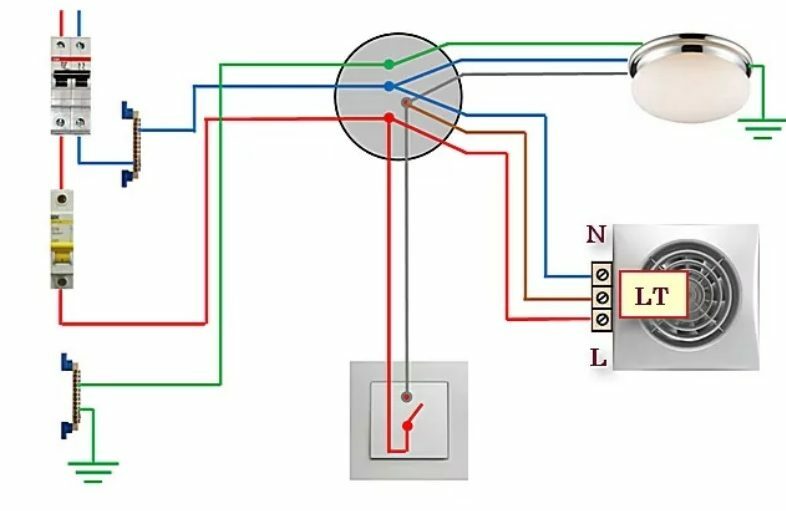
Connection diagram of an exhaust device with a built-in timer and a lighting system to a one-button switch. The N circuit from the luminaire and the fan is connected in the junction box and directed to the N bus
The circuit works almost flawlessly, but it also has a small drawback - the fan starts rotating even when there is no need for it. For example, if you look into the bathroom for a minute to turn on the washing machine or use some cosmetics.
For especially demanding users on the market there are models with two modes that can be switched by choosing a jumper setting - a small jumper, an element of the electronic board.
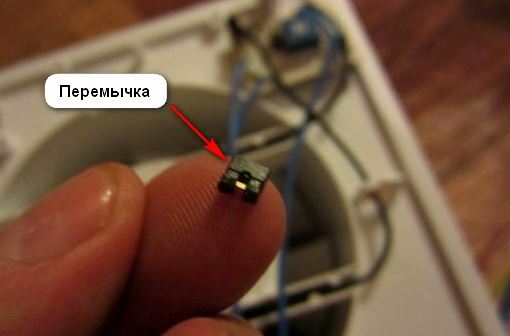
The jumper is a very small piece, a plastic and metal jumper that closes the required contacts. It is installed in the selected position before installing the fan in place; to change the mode, the device will have to be removed
Thanks to a small but important detail, the hood operates in two modes, which can be conventionally called "Toilet" and "Bathroom".
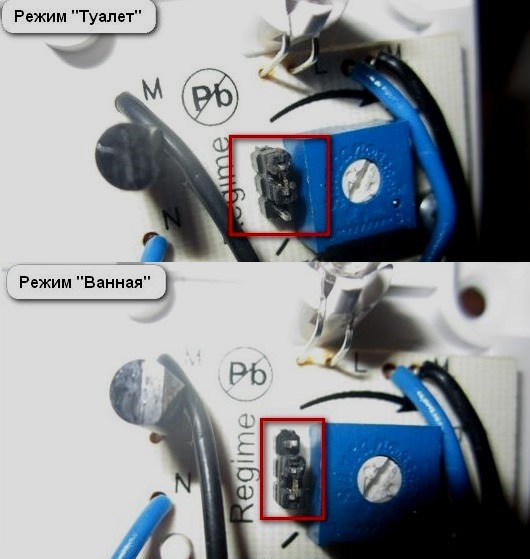
In the "Toilet" mode, the jumper must be fixed on the two upper contacts, in the "Bathroom" mode - on the two lower ones. The fan operating time is set in advance using the regulator, which is also located on the electronic board.
Consider the difference between the two modes:
- "Toilet" - after leaving the bathroom and pressing the switch button, the device will operate for a programmed period, for example, 3 or 5 minutes.
- "Bathroom" - the fan turns on only 90 seconds after the first key press. If you are indoors for less than one and a half minutes, it will not turn on. The operating time of the device is programmed in the same way as in the "Toilet" mode.
The second option is convenient if there is low humidity in the bathroom. When you just walk in to rinse your hands and exit quickly, the fan doesn't respond in any way.
As you can see, even when using a 1-way switch, there are several connection options. The use of a cooker hood with a timer significantly increases its capabilities.
Option # 2 - via a two-button switch
Now let's consider an option that is a little more difficult to connect, but much easier to use - with a 2-key switch. On sale you can find wiring products that are made specifically for this purpose - combining ventilation and lighting circuits.
We connect the fan and lighting
The main difference between the circuit is the use of a two-button switch. It is mounted in a gap in the "phase" so that one circuit goes to the lighting, the second to the hood.
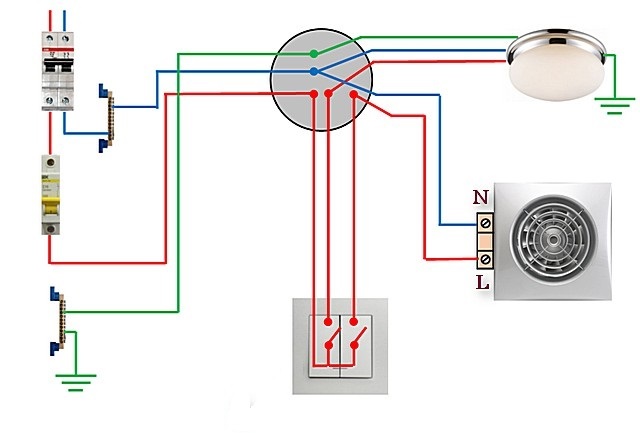
Wiring diagram of a 2-button switch to lamps and a fan. "Zero" from the N bus goes to all lighting fixtures and the hood, "ground" protects the lighting circuit
The advantage of the circuit is the autonomous connection of two systems with different functions - ventilation and lighting.
If you do not need to ventilate the room, press one button. If desired, you can use both keys, and then the fan will work while you are in the bathroom.

It is possible to ventilate without the presence of the user - this is very convenient when a bathroom or shower is used as a room for drying clothes, as well as in combined bathrooms
The disadvantages depend only on the forgetfulness of the tenants. Some users have a habit of pressing all the keys at once - so that they will probably turn on the one they need. In this case, you can get by with a single-key model.
If fan quiet, you can just forget to turn it off - and it will work unnecessarily all night. In such a situation, we can advise a cooker hood with a timer, which will limit the work within reasonable limits.
We connect a fan with a timer and light
This scheme should be considered separately, since it differs from the previous one in one important nuance. If everything remains the same in the lighting circuit - a phase wire goes to the luminaires from one of the switch keys, then the fan is connected differently.
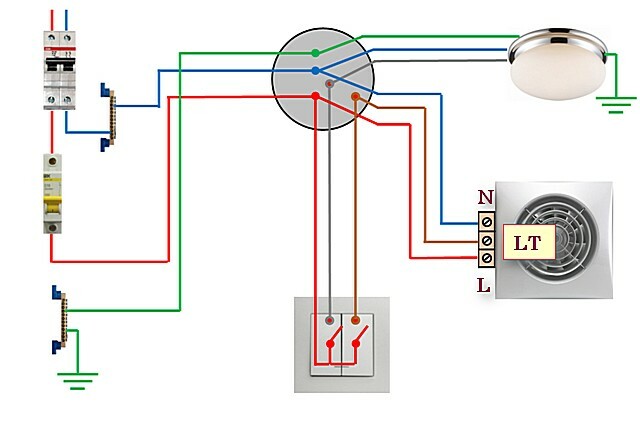
Connection diagram to a 2-button switch of two circuits - lighting and ventilation. The section of the "phase" wire connecting the switch with lighting fixtures is highlighted in gray
When the fan is connected, both "zero" and "phase" from the junction box follow to the fan terminals without breaking. And the device is connected with the switch by another "phase". It is this phase that must be connected to the LT terminal - the "phase" contact of the timer.
If you take a three-core wire (which is recommended), then the yellow-green ground can be used as the control "phase". If the lighting circuit is used for its intended purpose, then here it is absolutely free and can be connected to a timer.
The advantages of the circuit are the independent operation of the devices, and the fan will rotate in a well-defined time interval.
Option # 3 - installing an additional switch
What if the wires are laid deep in the grooves and a beautiful expensive switch has already been installed on the lighting circuit, and suddenly forced ventilation is required?
Next to an already installed switch or in another place, you can put another onedesigned specifically for the fan.
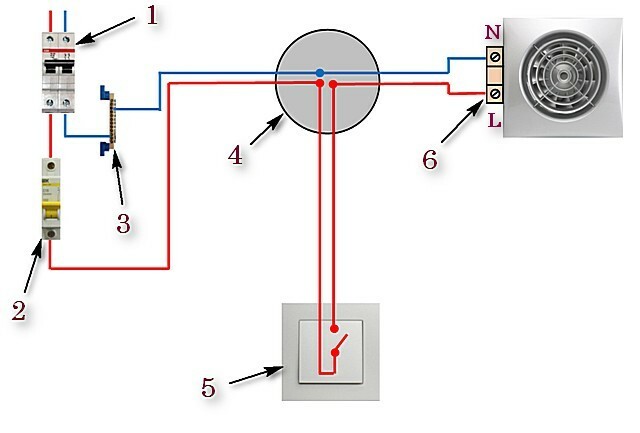
Simple diagram of the hood connection to a separate switch: 1 - general circuit breaker on the board; 2 - automaton for a dedicated circuit; 3 - "zero" bus; 4 - junction (junction) box; 5 - 1-key switch; 6 - fan
If in other circuits exclusively 3-core wires are used, then "earth" is not required here, since household axial fans of the overhead type are made of plastic. All connections are made by "phase" and "neutral" wires.
Instead of a junction box, a recessed socket is often used. The depth is necessary to freely place the connectors. terminal blocks and the working part of the switch.
General installation instructions
Whichever scheme you prefer, the installation of devices and the connection of wires is the same. For work, you need to select the appropriate devices in advance, prepare the tools, and if necessary, grind down the walls. We offer step-by-step installation instructions.
Stage 1 - execution of "rough" work
The question of forced ventilation arises when residents notice that it does not cope with its tasks. This is checked in a simple way: if the flame of a match tilts towards the shaft - the hood works, if it is directed vertically upwards and does not fluctuate - then mine requires cleaning.
Before installing the fan, the ventilation duct must be cleaned. We do not recommend doing this on your own, especially if the management company or service organization is responsible for the maintenance of the house. It is necessary to call specialists who will carry out the necessary measures.
The bathroom, according to PUE (clause 1.1.13), refer to premises of increased danger, since the degree of humidity reaches 60% or more. This means that all electrical appliances must have a special protection, and wires and contacts must be hidden from direct splash water.
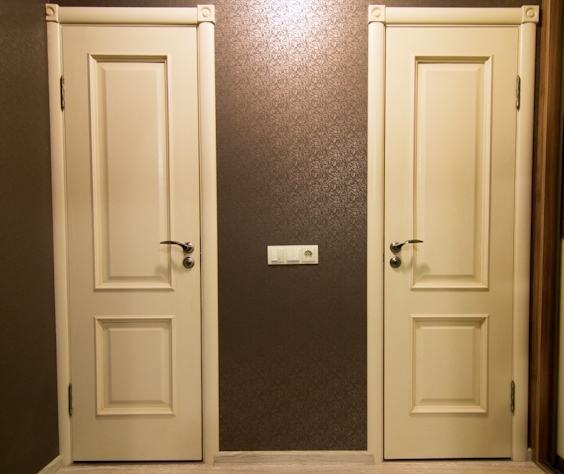
According to the rules, switches are installed outside the bathroom - near the door outside. However, in modern apartments there are spacious combined bathrooms, including areas that are safe for installation.
To mask the wires in the walls, even before finishing, grooves are laid - channels for electrical wiring. If you plan to do repairs, then it is better to install the fan at the same time as installing other electrical appliances.
So, "rough" work consists in cleaning the mine and chipping the walls for wiring. Additionally, you need to prepare a hole in the wall for installing the fan and make recesses for the socket and junction boxes (if necessary).
Stage 2 - preparation of tools and materials
Electrical work usually does not require the involvement of any special tool - usually everything you need is even from amateurs.
Image gallery
Photo from
Before starting any installation work, you should accurately determine the installation locations, measure the required amount wires, check again whether the devices are suitable in size - for this they use a tape measure, a square, a ruler and pencil
The switch and fan are installed on self-tapping screws, less often sealant is used to preserve the cladding - for example, already laid tiles in the bathroom. The timer can also be adjusted with a flat screwdriver.
Power tools are often required if it is necessary to lay channels for wires, to make recesses in concrete walls. If you do not have a personal tool, you can rent it from a construction company or repair organization.
The conductors can be switched in various ways: soldering, connecting with Vago-type terminals, enclosing them in sleeves. For a high-quality connection, there is a special crimping tool - pliers
Marking material: tape measure, pencil or marker
Phillips and slotted screwdriver set
Wall chaser or impact drill
Crimping tool for connecting wires
The selection of materials should be taken very seriously - after the electrical work is done bathroom decoration, most often expensive, which you will not want to disturb for the next 10-15 years. All wires, wiring accessories, devices and consumables must be of high quality, factory-made, with a guarantee.
The minimum required for a hood device:
Image gallery
Photo from
We recommend choosing a model that meets the following requirements: productivity - at least 25 m³ / h, noise level - up to 40 dB, degree of protection - IP34 and higher. In size, it should fit the hole in the ventilation duct.
The type of switch is selected depending on the selected circuit, theoretically, both varieties are suitable. Pay attention also to the brand, degree of protection, installation method. Design is also important - the device will be in a conspicuous place
The best option is a three-core VVG cable with a cross section of 2.5 mm for reliability, although 1.5 mm is enough. We do not recommend buying wires without symbols from an unknown manufacturer, since safety always comes first.
To connect low-current lighting systems or a fan, you can safely use plastic self-clamping terminals in a transparent case. Models Wago 2273 or 773 series are small in size and fit even in a wall box
Axial household fan with or without timer
One-key or two-key switch
Waterproof insulated three core wires
Wago wire terminals
If you decide to crimp the veins with sleeves, then prepare both the pliers and sleeves in advance. But soldering of wires is used less and less because of the complexity and duration of the process itself.
Also, from technology, a construction vacuum cleaner may be required, and from materials - a sealant.
Stage 3 - completing the connection process
Start by installing the fan. We stretch the wires through the channels in advance - from the switch to the hood and the places where the lamps are installed. For protection, all cables located in the bathroom space can be enclosed in corrugated insulating pipes.

In order not to experiment with different installation methods, we suggest choosing a fan model, corresponding in size to the hole in the ventilation shaft or slightly larger than it - for overhead models
The fan is either "set" on self-tapping screws (dowels), or fixed on a sealant. In the first case, it is easier to dismantle it, but during installation, the lining can be damaged if it has already been done.
Work order:
- We unscrew the decorative panel from the device, remove it together with the mosquito net.
- We place the cable in the shaft so that it does not interfere with air circulation, remove the corrugation from the ends of the wires.
- We bring the power cable into a specially designed hole.
- We put the fan in place, tighten the screws.
Before attaching the decorative panel, we make the connection.
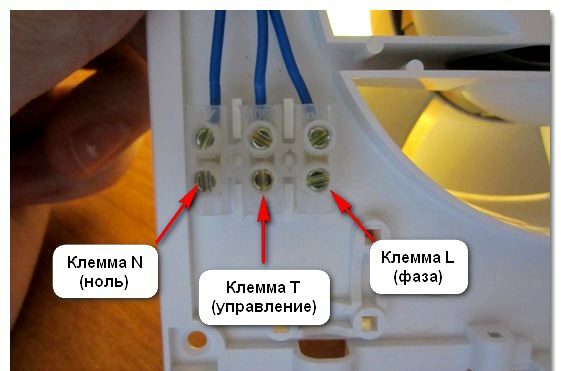
Option of connecting conductors to the “Era” fan terminal block. A voltage of 220 V is supplied to the L and N terminals, and the T terminal is necessary to control the timer - the "phase" connects it to the switch
The final step is to install the decorative cover by tightening the mounting screw. As a result, all wires must be masked in the device or in the wall.
We connect the veins of the switch according to the selected scheme, the designations on the diagrams are traditional.
In the fan, the layout was as follows:
- red - terminal L;
- blue - terminal N;
- yellow-green - T or LT.
We recommend that you familiarize yourself with color-coded wires in electrics.
What do experienced electricians advise not to do?
First, do not connect the bathroom fan directly to the light bulb. Then you will deprive yourself of comfort - the fan will always work only when the light is on, including when you are taking a bath.
Secondly, it is not recommended to install the switch indoors. If the project requires confirmation in the appropriate authority, you simply will not receive it.
Thirdly, it is not advised to use complex electrical devices and all kinds of sensors. They often break due to high humidity, take up space on the walls and do not look very aesthetically pleasing. The simpler the devices and the connection, the fewer problems with them.
Conclusions and useful video on the topic
Details about installing the hood in simple language:
The nuances of installation on tiles:
Instructions on the use of Vago terminals:
Fan selection recommendations, testing:
If you have planned to make repairs in the bathroom on your own, including updating the lighting system, then installing a fan will seem to you a simple and quick affair. The main thing is to decide at the start with the operating mode of the hood, choose a reliable model and correctly connect to a one- or two-button switch.
Remember: whichever scheme you prefer, the installation should be carried out in accordance with generally accepted requirements and safety rules.


